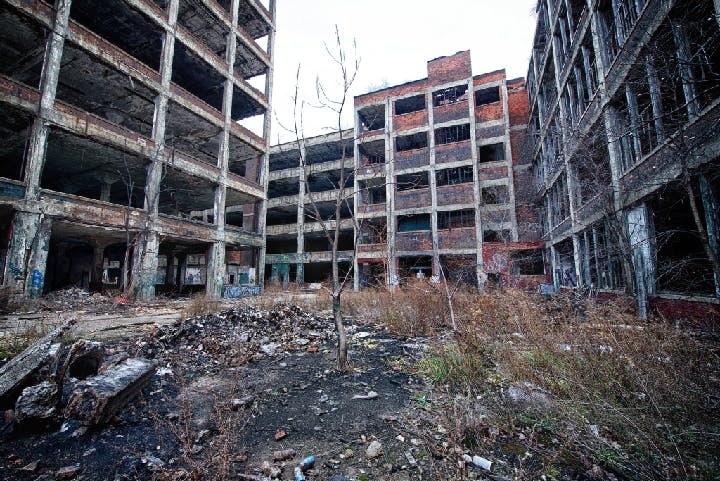Rust Belt cities have contaminated soil. Let’s plant food there.
– Alle Tyler
The folly and budding possibilities of urban farming. It can help to feed those in need, and, with the right vegetation, absorb harmful soil contaminants from post-industrial cities’ past lives.
The U.S. has a worrying trend of abandoning its cities once their core industries go belly up. Detroit, Cleveland, Toledo, Buffalo — such struggling communities dot the landscape of America’s “Rust Belt,” and are often memorialized in “ruin porn:” pictures of burnt out, decaying houses and factories reclaimed by nature, with trees and grass growing determinedly through broken tiles.
Is this urban blight simply a pathetic tragedy? Some of Detroit’s civic boosters don’t think so, and are attempting to turn these vacant lots into (literal) seedbeds of potential. With support from groups like Keep Growing Detroit (KGD), urban farming has taken off in the city. The number of farms & gardens within Detroit’s borders has grown from fewer than 100 to over 1,400 since 2000, and, by one estimate, nearly 20,000 people have started gardening.
Not only are these urban gardens and farming initiatives recycling and transforming old lots, they are also addressing pressing quality-of-life issues in the city. For many Detroiters, access to fresh fruits and vegetables is limited. An article in Forbes magazine recently reported that “only 19 percent of [the city’s] food stores carry the mix of foods recommended by the USDA.” Meanwhile, Detroit’s urban gardens “now produce 200 tons of fresh fruits and vegetables per year,” and the “residents who work those gardens eat 2.5 more servings per day of fruits [and] vegetables than their neighbors.”
Detroit isn’t the only city trying to shrink the distance from farm to table by merging urban and agricultural life. The municipal government of Washington, D.C. passed the Urban Farming and Food Security Amendment Act in 2014 to encourage the establishment of farming plots throughout the city. San Francisco now offers tax incentives to property owners who turn empty lots into gardens and farms for the public benefit. And activists in New York got a ban on urban beekeeping lifted in 2010. But on issues of farming, Rust Belt cities might actually have an advantage over these thriving and well-populated locales; their vacant lots provide ample space for sustainable and local farming.
Others aren’t quite as optimistic about farming in post-industrial Rust Belt cities. Many critics have raised concerns that city soil is frequently contaminated with heavy metals, lead, and other chemicals — PAHs, petroleum products, or surfactants — that reflect a plot’s past life. As produce is grown on this land, the soil contaminants can pose serious health risks to consumers and farmers alike. Cleanup methods like soil removal or soil washing can be very expensive and time-consuming; even soil tests can be prohibitively expensive for small nonprofit farms.
To allay the risks, researchers are developing cheaper and more time-efficient cleanup methods. One such approach, phytoremediation, utilizes plants’ root systems to absorb harmful chemicals from the soil and trap them in the plant, which can then be stored or safely discarded. Some of these plants can break down harmful chemicals into more benign forms.
There are also relatively simple solutions to keep contaminants out of crops. Farmers can build raised beds that separate new, clean soil from a polluted plot. They can also be strategic about the type of plants they grow; roots and leafy vegetables readily absorb lead, for instance, while fruits can often grow in lead-heavy environments without absorbing the chemical at dangerous levels.
Out of contaminated soil and problemed roots, something bright and new and fresh can grow. As urban farming advocates invigorate their cities, it almost works as a metaphor for the Rust Belt itself.
* * *
Further Reading:
Rebecca Kessler, “Urban Gardening: Managing the Risks of Contaminated Soils,” Environmental Health Perspectives, December 2013.
Jeff McMahon, “Why Can't More Cities Be Like Detroit? – EPA,” Forbes, August 6, 2014.
David E. Stillwell, Thomas M. Ratheir, and Craig L. Musante, “Comparison of Heavy Metals in Community Garden Produce versus Store-Bought Produce,” Connecticut Department of Agriculture Bulletin 1020, August 2008.
Photo courtesy of Mike Boening Photography
